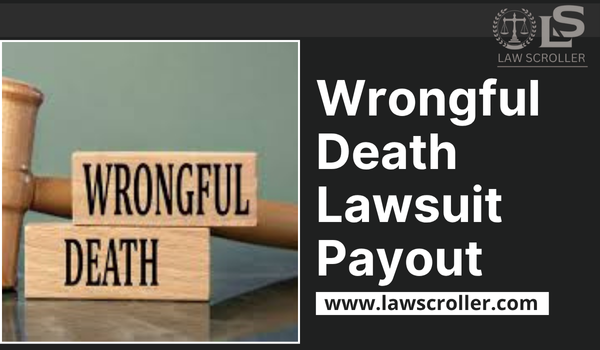Losing a loved one is painful enough. But when that loss happens because someone else was careless — a drunk driver, a hospital mistake, a faulty product — the grief often mixes with anger and confusion. Families naturally ask: What can we do?
That’s where a wrongful death lawsuit comes in. It’s a way for surviving family members to seek justice — and financial compensation — for the preventable loss of a loved one.
In this guide, we’ll break down what a wrongful death lawsuit payout looks like in simple, everyday language. You’ll learn who can file, how these cases work, how much families can expect in settlements, and what’s happening in these cases today.

Background: What Is a Wrongful Death Lawsuit?
A wrongful death lawsuit is a civil case filed when someone’s death was caused by another person’s negligence, recklessness, or intentional act.
It’s not a criminal case — the person responsible might also face criminal charges, but this lawsuit is separate. The goal here isn’t to send anyone to jail; it’s to recover money that helps the family cope with financial and emotional losses.
Common examples include:
- Fatal car, truck, or motorcycle accidents
- Medical malpractice, such as surgical or medication errors
- Workplace accidents caused by unsafe conditions
- Defective products that malfunctioned or were unsafe
- Nursing home neglect or abuse
- Intentional violence, such as assault or homicide
When a wrongful death occurs, family members can file a lawsuit to hold the responsible party — whether that’s a person, company, or government agency — financially accountable.
Who’s Affected (Who Can Claim)
Each state has slightly different rules on who can file a wrongful death claim, but generally, these people have the right to bring a case:
- Spouse or domestic partner of the deceased
- Children (biological, adopted, or sometimes stepchildren)
- Parents (especially if the deceased was unmarried or a minor)
- Estate representative, if the person had a will
In some states, extended family — like siblings or grandparents — may be eligible if they were financially dependent on the deceased.
The compensation isn’t just about money. It’s also about recognition: confirming that a life was lost due to someone else’s wrongdoing.
Timeline: How a Wrongful Death Case Works
A wrongful death lawsuit can take several months or even years. Here’s a simple breakdown of what usually happens:
| Stage | What Happens |
| 1. The Incident | A fatal accident or event occurs, often due to negligence (like a car crash or medical mistake). |
| 2. Investigation | The family or their lawyer collects evidence — accident reports, medical records, witness statements, expert opinions. |
| 3. Filing the Lawsuit | The attorney files a wrongful death complaint in civil court against the responsible party (an individual, company, or agency). |
| 4. Discovery Phase | Both sides share documents, question witnesses, and build their arguments. |
| 5. Negotiation & Settlement | Many wrongful death cases settle out of court to avoid a long trial. |
| 6. Trial (if needed) | If no settlement is reached, a jury decides whether the defendant is liable and how much money should be awarded. |
Most families never see the inside of a courtroom — the majority of wrongful death claims end in a settlement, which means both sides agree on an amount before trial.
What Families Can Recover
The wrongful death lawsuit payout can vary widely based on the case — from tens of thousands of dollars to several million. The exact amount depends on what the court (or insurance company) believes the family lost financially and emotionally.
Common types of damages include:
- Economic Damages:
- Lost wages and future income (what the deceased would have earned).
- Medical bills related to the fatal injury or illness.
- Funeral and burial expenses.
- Non-Economic Damages:
- Pain and suffering (for both the deceased and their family).
- Loss of companionship, guidance, and support.
- Emotional distress for surviving family members.
- Punitive Damages:
- These are rare but possible if the defendant’s conduct was especially reckless or intentional (for example, a drunk driver or a company that ignored safety warnings).
Typical Payout Ranges
- Car accident wrongful death settlements: $250,000 – $2 million
- Medical malpractice wrongful death: $500,000 – $3 million
- Workplace or construction accidents: $200,000 – $1.5 million
- Defective product deaths: $1 million – $5 million+ (especially in class-action cases)
These are national averages — each case depends on the evidence, the deceased’s age and income, and state laws on damage caps (some states limit how much can be awarded for pain and suffering).
What to Watch Next (Recent Trends & Case Updates)
- Rising Settlement Amounts
Juries and insurance companies are awarding higher wrongful death lawsuit payouts as awareness grows about corporate and institutional negligence. Recent verdicts in trucking and hospital negligence cases have crossed $10 million or more.
- State Law Changes
Some states are updating laws to make it easier for nontraditional family members — like unmarried partners or stepchildren — to file claims.
- Corporate Accountability
Major companies facing wrongful death lawsuits are opting for pre-trial settlements to avoid bad publicity. These settlements often include policy changes or safety improvements in addition to compensation.
- Statute of Limitations
Each state limits how long families have to file a wrongful death lawsuit. Usually it’s two to three years from the date of death, but some states are stricter (as little as one year).
If you believe your loved one’s death was preventable, it’s important to talk to an attorney as soon as possible. Missing the filing deadline can mean losing your right to compensation entirely.
FAQ: Wrongful Death Lawsuit Payout Explained
Q1: How do wrongful death lawsuit settlements work?
Most cases settle before going to trial. The responsible party (or their insurance company) agrees to pay a certain amount in exchange for the family dropping the lawsuit. Settlements are usually confidential but may involve lump-sum payments or structured payments over time.
Q2: Who gets the money from a wrongful death settlement?
The payout typically goes to surviving family members — usually the spouse, children, or parents — or is distributed through the deceased’s estate according to state law.
Q3: How long does it take to get a wrongful death settlement?
Smaller, straightforward cases can settle in a few months, but complex cases (like medical malpractice or corporate negligence) can take one to three years or longer.
Q4: Do wrongful death payouts get taxed?
Generally, compensatory damages (money for lost income, pain, or suffering) are not taxable under federal law. However, punitive damages and interest earned on the settlement can be taxed. Always check with a tax professional.
Q5: What if the deceased had no income — can the family still sue?
Yes. Even if the person wasn’t earning money, the family can claim loss of companionship, care, and emotional support — all of which have financial value in wrongful death law.
Q6: How much does it cost to hire a wrongful death lawyer?
Most attorneys work on a contingency fee basis, meaning they only get paid if you win or settle. The typical fee is 25–40% of the final settlement or verdict.
Key Takeaway
A wrongful death lawsuit payout won’t bring a loved one back — but it can help families rebuild their lives, pay medical and funeral costs, and find a sense of closure. These cases also play a crucial role in holding individuals, companies, and institutions accountable for preventable harm.
If you’ve lost someone because of another person’s negligence, you may have the right to file a wrongful death claim. An experienced attorney can review your case, estimate its potential value, and guide you through the process.


 Oliver Johnson is LawScroller’s Senior Legal Correspondent specializing in civil litigation, class actions, and consumer lawsuit coverage. He breaks down complex settlements and court decisions into clear, practical guidance for readers.
Oliver Johnson is LawScroller’s Senior Legal Correspondent specializing in civil litigation, class actions, and consumer lawsuit coverage. He breaks down complex settlements and court decisions into clear, practical guidance for readers.